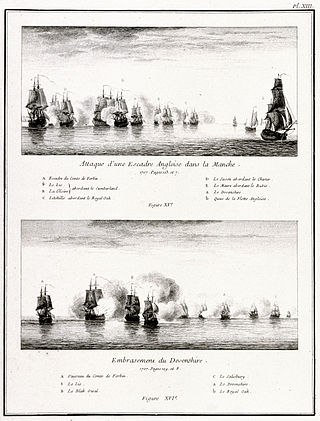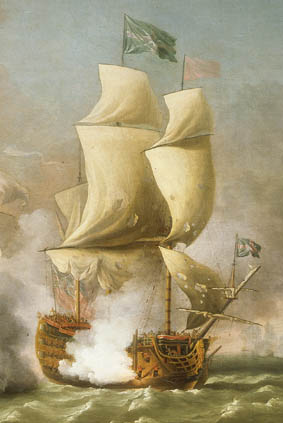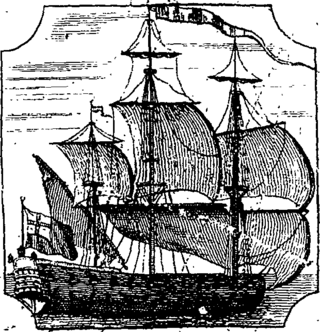
HMS Charles was a 96-gun first-rate ship of the line of the Royal Navy, built by Christopher Pett at Deptford Dockyard until his death in March 1668, then completed by Jonas Shish after being launched in the same month. Her name was formally Charles the Second, but she was known simply as Charles, particularly after 1673 when the contemporary Royal Charles was launched.
The Worcester was a 48-gun Third rate frigate built for the navy of the Commonwealth of England at Woolwich Dockyard by Master Shipwright Andrew Burrell and was launched in 1651). She was named for the Parliamentary victory at the Battle of Worcester.

HMS Salisbury was a 50-gun fourth rate ship of the line of the Royal Navy, one of eight such ships authorised by the Navy Board on 24 December 1695 to be newly built ; the others were the Hampshire, Dartmouth, Winchester, Worcester, Jersey, Carlisle and Tilbury. The contract for the Winchester was signed with shipbuilders Richard and James Herring in 1696, for the ship to be built in their yard at Baileys Hard on the Beaulieu River in Hampshire, England, and she was launched there on 18 April 1698.

HMS Captain was a 70-gun third rate built at Woolwich Dockyard in 1677/78. After sitting in Ordinary for ten years she was in active commission for the War of the English Succession fighting at Beachy Head and Barfleur. She was in Ordinary until 1706 when she was rebuilt. She was in active commission for the last half of the War of Spanish Succession but fought in no major engagements. She was at the Battle of Passero I 1718. She was rebuilt in 1720/22. She made two forays in to the Baltic though the bulk of her late career was spent as guardship at Portsmouth. She was hulked in 1740 and finally broken in 1762.

HMS Lancaster was an 80-gun third rate ship of the line of the Royal Navy, launched at Bursledon on 3 April 1694.

HMS Canterbury was a 60-gun fourth-rate ship of the line of the Royal Navy, launched at Deptford on 18 December 1693.

HMS Barfleur was a 90-gun second rate ship of the line of the Royal Navy, launched at Deptford Dockyard on 10 August 1697.

HMS Weymouth was a 50-gun fourth rate ship of the line of the Royal Navy, launched at Portsmouth Dockyard on 8 August 1693. She was one of two 50-gun ships ordered on 15 August 1690 to be built by Master Shipwright William Stigant at Portsmouth Dockyard. However, unlike the Norwich, the Weymouth was delayed until 1693 and - instead of the 123 ft length originally specified - was lengthened to 132 ft 4 in, thus becoming the prototype for the 1693 batch ordered with a design extended to some 130 ft.

HMS Dartmouth was a 50-gun fourth-rate ship of the line of the Royal Navy, one of eight such ships authorised by the Navy Board on 24 December 1695 to be newly built ; the others were the Hampshire, Winchester, Salisbury, Worcester, Jersey, Carlisle and Tilbury. The contract for the Dartmouth was signed in 1696 with shipbuilder James Parker, for the ship to be built in his site in Southampton, taking the name of the previous Dartmouth of 1693, and she was launched there on 3 March 1698.
HMS Winchester was a 50-gun fourth rate ship of the line of the Royal Navy, one of eight such ships authorised by the Navy Board to be newly built ; the others were the Hampshire, Dartmouth, Salisbury, Worcester, Jersey, Carlisle and Tilbury. The contract for the Winchester was signed with shipbuilders John and Richard Wells in 1696, for the ship to be built in their yard at Greenland North Dockyard, in Rotherhithe, and she was launched there on 17 March 1698.

HMS Lichfield was a 50-gun fourth-rate ship of the line of the Royal Navy, one of five such ships authorised on 16 November 1693 (three to be built in different Royal Dockyards and two to be built by commercial contract. The Lichfield was built by Master Shipwright William Stigant at Portsmouth Dockyard and launched on 4 February 1695. She was first commissioned in that year under Captain Lord Archibald Hamilton, for service in Home Waters.

HMS Severn was a 50-gun fourth-rate ship of the line of the Royal Navy, launched at Sir Henry Johnson's Blackwall Yard on 16 September 1695. The commercial contract had originally been agreed with Johnson on 16 November 1693, but the latter two were delayed and a fresh contract for them agreed on 7 December 1694.

HMS Guernsey was a 50-gun fourth rate ship of the line of the Royal Navy, one of four ordered in September 1694 to be built by commercial contracts; eight further ships of this type were ordered on 24 December. The Guernsey was built by Sir Henry Johnson's Blackwall Yard and launched on 6 July 1696.
HMS Warwick was a 50-gun fourth rate ship of the line of the Royal Navy, one of four ordered in September 1694 to be built by commercial contracts; eight further ships of this type were ordered on 24 December. The Warwick was built by Robert and John Castle at their Deptford shipyard and launched on 20 August 1696.

HMS Bristol was a 50-gun fourth-rate ship of the line built for the Royal Navy in the first decade of the 18th century.
The 1719 Establishment was a set of mandatory requirements governing the construction of all Royal Navy warships capable of carrying more than 20 naval long guns. It was designed to bring economies of scale through uniform vessel design, and ensure a degree of certainty about vessel capability once at sea, and was applied to all vessels from the first-rate to the fifth-rate. Once in effect, it superseded the 1706 Establishment, which had specified major dimensions for ships of the second-rate, third-rate and fourth-rate only.
HMS Aldborough was a 24-gun sixth-rate ship of the Royal Navy, purchased in 1706 and in service in Mediterranean and English waters until 1727 when she was rebuilt as a 374 ton sixth rate in accordance with the 1719 Establishment for Sixth Rates. After the rebuild she spent her career in the West Indies, Home Waters and the Mediterranean. She was finally broken at Deptford on 31 March 1742.
HMS Seaford was a member of the standardized 20-gun sixth rates built at the end of the 17th century. After she was commissioned she had a very varied career, starting in the Mediterranean then the Irish Sea, then to Newfoundland, the North Sea followed by a great repair then to the Leeward Islands. She was dismantled in 1722 and rebuilt as a bomb vessel in 1727 than a 20-gun sixth rate in 1728. She served in the West Indies, America and the Mediterranean. She was finally broken in 1740.
HMS Rye was a member of the 1719 Establishment Group of 20-gun sixth rates. After commissioning she spent her career in Home waters on trade protection duties. She was broken up in 1735.
HMS Experiment was a fifth rate built under the 1689 programme built at Deptford Dockyard. Her guns were listed under old terms for guns as demi-culverines, sakers and minions. After commissioning she spent her career in Home Waters, North America, Mediterranean and the West Indies. She was reduced to a 20-gun sixth rate in 1717 then rebuilt as a 1719 Establishment sixth rate in 1724. Her breaking was finally completed at Portsmouth in 1738.











